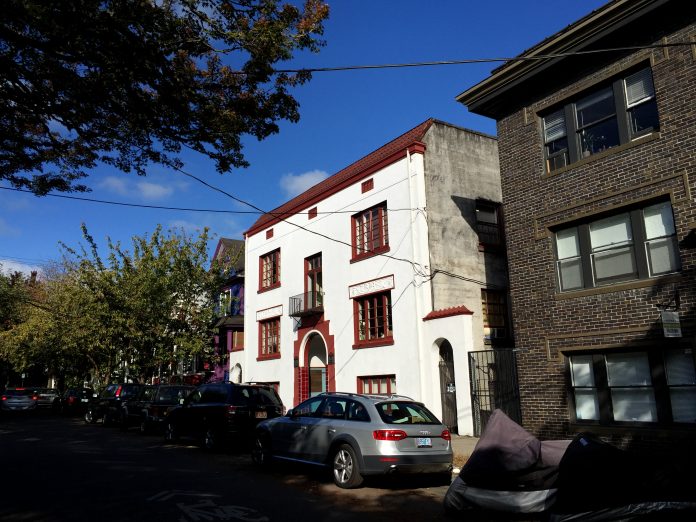Seattle is currently undergoing its longest and largest period of prolonged job growth, rapid building, and in-migration since the Second World War. This boom has no discernible end in sight as job growth in the tech sector remains high and international trade and foreign real estate investment grow.
New residents of the region will spend their time four ways: working, learning, sleeping, and doing everything else, from eating out to shopping for tools to playing sports. The question “where will they do this?” is the most contentious issue in Puget Sound politics today. Historically, this question has been given two answers:
- Allow growth to spill over the edges of suburban cities or into unincorporated areas of King, Pierce, and Snohomish Counties by overwhelmingly constructing single-family housing on large lots in developments with a “loops and lollipops”-style street grid, along with malls and low-rise shopping centers that provide crucial services and amenities. This method, which I’ll call the “sprawl strategy”, famously prevailed throughout the United States after World War II due to many factors. The main factors were unprecedented investment into roads and highways, the falling cost of owning and maintaining a private automobile, and the relative ease of redeveloping wilderness or farm land as opposed to previously developed land. Although planners and environmentalists have tried to call attention to the costs of the sprawl strategy, the overwhelming majority of new residential and commercial development in the United States since 1950 has taken the form of sprawl. After 1990, the sprawl strategy became less viable in Washington State due to the passage of the Growth Management Act, which forces counties to restrict urban development to circumscribed growth areas, the boundaries of which are updated based on urban growth. While the pressure to build continues to exert itself on the Puget Sound urban growth boundary, it is clear that the majority of future population and business growth will happen in already developed areas.
- Channel growth into certain developed areas using high level coordination to align city-specific comprehensive plans and zoning codes with growth goals that are set for the entire Puget Sound region. This method, which I’ll call the “urban concentration strategy,” is implemented by the Puget Sound Regional Council (PSRC), an interurban organization which reviews local comprehensive plans and coordinates regional planning throughout the Puget Sound. The urban concentration strategy has contributed to the greater density of Puget Sound area cities relative to cities throughout the United States that are comparable in size and growth rate. If the urban concentration strategy is successfully implemented, this trend will continue. The PSRC’s VISION 2040 plan intends to house 32% of the region’s growth in five cities (Bellevue, Bremerton, Everett, Seattle, and Tacoma) and only 25% is unincorporated urban areas or rural areas (which include unincorporated but highly developed White Center and Skyway-Bryn Mawr). The design of the urban concentration strategy is (obviously) urban, with an emphasis on housing new arrivals in multi-family housing and channeling employment into dense commercial and industrial areas.
What if there was a third strategy for accommodating growth? Ideally, this strategy would:
- Boost housing capacity;
- Provide a wide array of “missing middle” housing options for Seattle families in areas that are rich with family amenities; and
- Put more amenities in single-family neighborhoods.
I believe that there is a strategy that would accomplish this, even though it’s politically controversial and challenging to plan for. Existing single-family areas can be rezoned in an way that will include a mix of uses and that will accommodate a large share of future growth. The Japanese model of single-family mixed-use residential zoning is a useful guide.
What is Zoning in Japan?
Zoning has been required by national law in Japan since the passage of the City Planning Act in 1968. American cities are not technically required to zone, although it has continually been ruled constitutional for individual cities to mandate zoning. In Japan, all prefectures and cities must designate zones in their plan. Furthermore, the national government of Japan has an active role in developing and enforcing city plans and zoning arrangements by supplying information to municipalities on national level and in some cases official guidance, like a national version of the Puget Sound Regional Council. This is a marked contrast to American zoning, which is almost always enforced as a municipal ordinance.
The degree to which zoning is streamlined and standardized by the City Planning Act has no parallel in the United States. Generally, there are 12 zones in the entire country of Japan that are legal to use in city plans, and are delegated by the government. These are:
- Two categories of Residential District (Categories I and II – inclusive and exclusive);
- Two Medium- to High-Rise Residential Districts (Categories I and II – inclusive and exclusive);
- Two General Residential Districts (Categories I and II – inclusive and exclusive);
- Quasi Residential District;
- Two Categories of Commercial Districts (neighborhood and general);
- Three Categories of Industrial District (quasi, general, and exclusive);
There is also a series of rare, special use districts, but the majority of land is zoned into one of the above zones. Specifications on building within the zone are detailed in paragraph 40(4)(2)i of the Building Standards Law. Maximum floor area ratios (FAR) and building coverage ratios (BCR) are regulated on a national basis as well, ranging from an FAR of 0.5 and a BCR of 0.6 for low-rise and mid-rise residential zones to a maximum FAR of 13 and BCR of 8 for dedicated commercial zones. As a contrast, the City of Seattle has 32 general zone types, none of which apply outside the city. The end result is a common set of 11 zoning solutions that Japanese planners can apply to urban development. One author calls this system the “centralized bureaucracy” system of planning and zoning.
Nationwide standardized and pre-established rules are transmitted, virtually one-way, from the central to local governments in the form of notifications, standards, operational guidelines and procedures, etc.
While municipalities or 12 prefectures have the final say in drawing the zones, they are using a toolbox put together by the federal government in Tokyo.
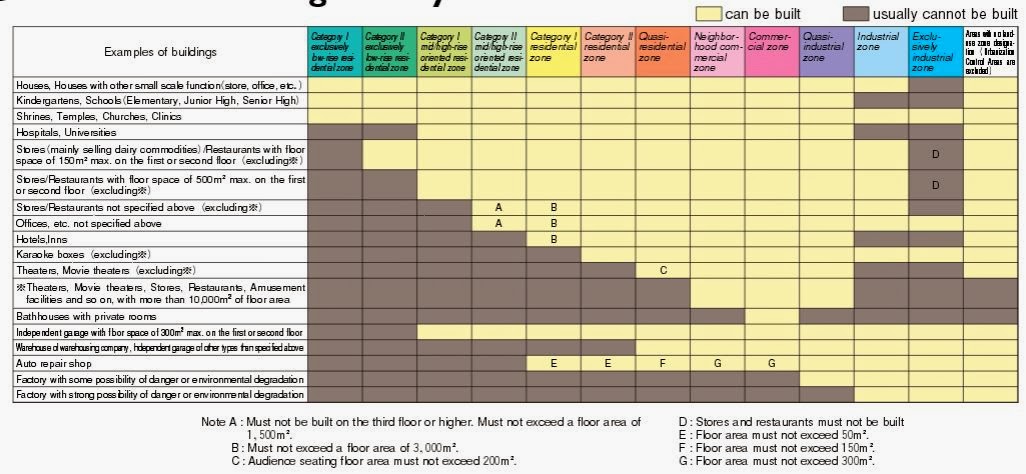
Zoning occurs in a different planning context than the West. Cities cannot draw up their own zoning categories, nor are individual zones necessarily the basic units of zone planning. The City Planning Act locates urban zoning in “city planning areas”–heavily populated zones that require “integrated urban development, development and preservation in due consideration of natural and local conditions and the current situations in other matters stipulated by Ordinance of the Ministry of Land, Infrastructure, Transport, and Tourism.” Designation of responsibility for planning areas that span more than one prefecture, revision of city planning areas, and abolition of city planning areas are all made by the same ministry in Tokyo. City Planning Areas are in turn divided into “urbanized areas” which are already developed or to be zoned and developed within ten years, and “urban restriction areas” which are restricted to development. As of 1999, 92% of the Japanese population lived in city planning areas, and 66% lived in urbanized areas themselves. 4% of the total land in the country is in urbanized areas.
Where zoning regulations in the United States are varied, heterogenous, and voluntary, regulations in Japan are top down, nationally consistent, and mandatory for all urban areas. Japanese residential zoning also emphasizes mixed uses to an extent that is almost never found in American single-family zoning.
What’s This Got To Do With Seattle’s Housing Crisis?
Although Seattle is a dense city by North American standards, the majority (roughly two-thirds) of the city’s land is reserved for single-family housing. A picture is worth a thousand words, so I’ll let the current generalized zoning map of the city tell the story:
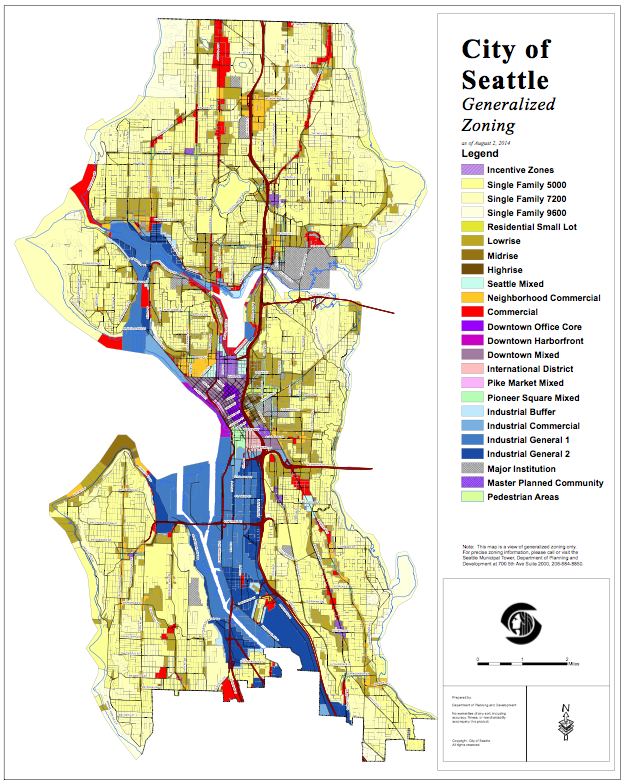
Outside of Central Seattle, the University of Washington, and the swathes of land reserved for industrial and maritime usage, the majority of the city’s land is is one shade of yellow or another, lying in the SF-9600, SF-7200, or SF-5000. What does Seattle allow there? Not much:

On two-thirds of Seattle’s land, it’s legally impermissible to build anything other than a single-family home (certain types of institutional or public uses excepted) covering more than 35% of a lot that’s no less than 5,000 square feet, preferably with an alley-accessible parking space.
In Seattle, converting land away from single-family zoning is a slow process. Single-family zones can change to either LR (Lowrise) or RSL (Residential Small Lot) under certain conditions. These zones can accommodate more residents than the SF zones by a considerable amount–a lot zoned RSL can host up to 12 units if it has “cottage” designation and LR can accommodate multi-family development. In denser parts of Seattle, like Capitol Hill and the close-in North Seattle neighborhoods, these zones are quite extensive, but overall they remain a small part of the city’s urban zoning framework.
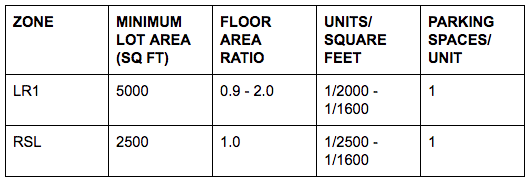
Rezoning an SF-5000 area to an LR1 or RSL neighborhood will increase the area’s housing capacity by a factor of two to three, depending on developmental factors. Taken together, these five zones most closely resemble the Japanese Category I and II Residential Low Rise zones, though with a very different urban scale.
Outside of infill developments in Central Seattle and urban villages, the slow conversion of single-family zones to low-rise zones is Seattle’s best hope for increasing housing development capacity. In July 2015, HALA Strategy SF.2 explicitly called for “more variety of housing types, such as small lot dwellings, cottages, courtyard housing, duplexes and triplexes, in Single Family zones.” SF.2 “does not eliminate the option of single-family housing; rather, it increases the opportunities for more efficient use of very limited land resources” and went on to note that “low density use would be less intense than the Lowrise 1 multifamily (LR1) zone.” However conservative this recommendation, it hinted that change may be coming to single-family zones.
This strategy was so controversial that it was struck from HALA almost immediately, but it should not be abandoned. The Japanese model for inclusive residential zoning provides an example of how a wider variety of housing types and uses, including low-level retail uses, can be allowed to exist in Seattle’s single-family neighborhoods. Single-family mixed-use zoning is a change that Seattle can implement that will benefit new arrivals, middle and low income people, and residents of single-family neighborhoods.
Why include more in single-family zones?
Inclusionary single-family zoning will increase future housing supply, the needs of which have been greatly underestimated. The Seattle 2035 Development Capacity Report’s analysis of the city’s zoning capacity concluded that the city has adequate capacity to grow based on current zoning configurations, estimating that 223,173 housing units could be added over the next two decades. While this model is somewhat conservative–it assumes that only underutilized parcels will be redeveloped and that any given redeveloped parcel will consist of a mix of residential and non-residential uses based on a ten year average for each zone–it still overestimates the capacity of Seattle’s current zoning to cope with stratospheric growth. Dan Bertolet at the Sightline Institute has penned a recent article concluding that the link between development capacity and housing provision is less direct than it may seem. The model estimates that the number of capacity units in single-family zones is 10,959, meaning that the 65% of the land area in Seattle occupied by single-family zones would host a total of 4.9% of all residential development between now and 2035. Single-family zones are simply not accommodating a reasonable share of housing growth.
Using the City of Seattle’s development capacity model, I calculated how many units Seattle’s single-family zones could yield if significant redevelopment through rezoning occurred. If all of Seattle’s single family land outside of urban villages were rezoned to allow residential small lot development, anywhere from 19,600 to 122,641 units could be produced depending on how much many currently developed parcels would be redeveloped. If this land was rezoned to accommodate low rise 1 housing, the equivalent figure would be between 122,641 and 205,939 units. This analysis shows that the inclusion of mixed uses in single-family land has a huge amount of potential for providing family housing.
Mixed-use single-family zoning will provide more family-friendly housing in amenity rich areas where current market and planning conditions make new construction difficult. One of the drawbacks of the urban concentration strategy for handling growth is its failure to deliver family-sized housing in the central city and urban village areas where it concentrates growth. Developers prefer the dependable profits that come from upscale apartments, mostly one-bedrooms, with retail on the ground floor. Meanwhile, there is virtually no room to add more capacity in the form of detached single-family housing. While 810 single-family structures were permitted in 2015, only 462 have been permitted in 2016. Since two- and three-bedroom apartment and condominium units are scarce, expensive, and frequently far from family amenities, expanding the area in which duplex, triplex, and quadplex development is allowed is the best way to guarantee a larger supply of single-family housing in the long-term.
Despite robust growth in the student age population of Downtown Seattle, no elementary or middle schools exist in the core of the city (one public school, the arts magnet Center School, is based in Uptown). The Seattle Public Schools Board has acted haltingly on this matter. In November 2014, the board voted down the acquisition of the most promising site for a new Downtown school, a disused Federal Reserve building, through a federal disposition process that would have allowed the district to acquire the site for free. Three months later, the board reversed its decision but was outbid in an auction by real estate developer Martin Selig. Downtown Seattle public school students will face daunting commutes to elementary and middle schools outside of their neighborhood into the foreseeable future. Park space is similarly concentrated in the lower density regions of Seattle that are almost exempt from having to accommodate new arrivals. Opening single-family neighborhoods with schools and family amenities to growth–with the potential to create 115,000 family-sized housing units over the baseline–will help young families stay in Seattle rather than flee.
Inclusionary single-family zoning has the potential to foster the growth of limited retail and commercial amenities serving neighborhood customers. Seattle currently implements Neighborhood Commercial (NC) zoning on major arterial streets and within urban villages. In addition, there is a separate pedestrian-designated zoning category (P) applying to NC zones along pedestrian-oriented commercial streets.
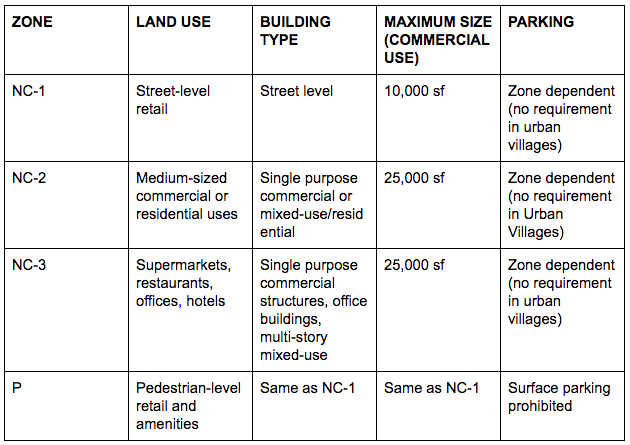
Allowances for limited types of commercial and retail use in residential zones is an interesting feature of the Japanese zoning system. Japan’s Category II (inclusive) low-rise zone allows for stores and restaurants with up to 150 square meters (or 1,615 square feet). Denser and more inclusive residential zones allow for even higher levels of use, with stores and restaurants having up to 500 square meters (or 5,382 square feet) of space permitted. The result is that Japanese consumers in major cities find it easy to walk to stores for their everyday needs.
Small neighborhood restaurants and stores can proliferate, as would “traditional”, “expanded”, and “hyper” convenience stores (as defined by the Association for Convenience and Fuel Retailing) offering a variety of products. Anders Meyer’s short study of nonconforming corner stores in Wallingford has noted their benefits for walkability and safety in that neighborhood and suggested design guidelines for future uses. If single-family zones in Seattle were changed to include limited commercial uses, residents in areas where neighborhood commercial are scarce or are too distant to walk or bike to will enjoy greater access to a variety of amenities and greater community life, and entrepreneurs will have more physical room to start new businesses. Seattle should consider incorporating features of neighborhood commercial zones into reformed single-family zones.
Conclusion
The growth pressures facing Seattle are so enormous that their effects touch on nearly every civic issue. The numbers speak for themselves:
- Amazon posted 11,042 job openings in King County, mostly in Seattle, in the summer of 2016.
- Monthly rents in Seattle grew by 9.7% between June 2015 and June 2016.
- Median sale price for homes in Seattle is $625,000.
The list goes on.
Although activists for the preservation of single-family zoning frequently cite the preservation of neighborhood character as their top priority, something more fundamental is at risk of being lost. If housing costs continue their meteoric rise, Seattle will become a city bifurcated between disproportionately elderly and wealthy single-family homeowners and one- or two-person households composed of wealthy professionals, with families and low-income people migrating away to greener, more affordable pastures. This is all to say nothing of the fact that British Columbia’s new excise tax on foreign real estate purchases may drive Chinese investment into the Seattle area, shooting demand for housing even higher.
There is an adage that goes “If we want things to stay as they are, things will have to change.” Seattle is one of the healthiest urban economies on the face of the Earth, and money, jobs, and new arrivals will continue to pour in. Unless urban centers, urban villages, and single-family zones all take a good share of new residential growth, Seattle’s ability to absorb this growth will be inadequate and inequitable. Japanese style mixed-use single-family zoning, adapted to the conditions of our single-family zones, offers us a way out, and will produce myriad benefits for all residents by contributing to affordable single-family housing, increased access to family amenities, and increased access to commercial and retail services.
Austin Bell is an urbanist, urban planner, and geospatial analyst currently residing in Columbia City.

